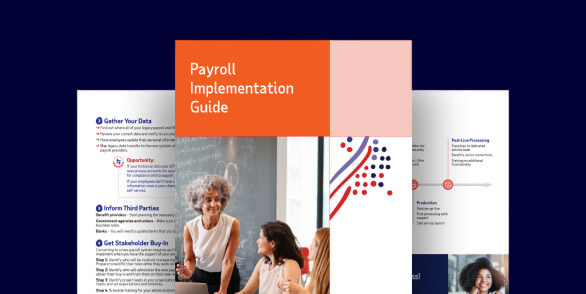insight
Payroll taxes: What they are and how they work
Need help reducing your risk of payroll tax penalties?
Most business owners probably already use some form of accounting assistance, whether it's a bookkeeper or software, but even with support, paying employees can be challenging. Those who plan on doing their own payroll and want to avoid payroll mistakes must thoroughly understand employer payroll taxes.
Table of Contents
What are employer payroll taxes?
Employer payroll taxes are taxes incurred when businesses hire people. Some of these taxes are paid by both the employer and the employee; others are paid only by employers. Examples include Social Security tax, Medicare tax and unemployment taxes.
Which payroll taxes are paid by employers?
Employers must pay payroll taxes every pay period. These include:
- Social Security, taxed at 6.2% for employees and 6.2% for the employer up to the taxable earnings cap
- Medicare, taxed at 1.45% for employees and 1.45% for the employer
- State unemployment taxes (varies by state)
- Federal unemployment, taxed at up to 6% for the employer on the first $7,000 paid to the employee
Social Security tax
The Social Security tax rate is 12.4%, half of which is paid by the employee and the other half by the employer. This tax has an annual wage base limit of $184,500.
Medicare tax
The Medicare tax rate is 2.9%, paid evenly by both employers and employees. An added 0.9% applies to employees who earn more than $200,000 per year. Additional Medicare tax is paid by employees only.
State unemployment tax
Employers should refer to state authorities for specific unemployment tax rates. Typically, only employers pay this tax, but in a few states, employees also contribute.
Federal unemployment tax
The federal unemployment tax rate ranges from 0.6 to 6%, depending on how much the employer pays in state unemployment tax. It is paid only by employers.

ADP makes the payroll tax process easy
Our automated system calculates, withholds, and pays payroll taxes for you.
How to calculate federal payroll tax withholdings
Unlike the flat rate FICA taxes, calculating federal income taxes is a little more complex. The calculation is based on:
- The employee’s adjusted wage amount
- The withholding amount indicated in wage bracket tables in Publication 15-T
- Any tax credits the employee receives
- Any additional withholding requested by the employee
To determine what to withhold for an employee who earns up to $100,000 per year and has completed the revised 2020 Form W-4, employers may use the IRS wage bracket method as follows:
1. Adjust employee’s wage amount
Wage adjustment may be necessary when employees complete Step 4 on Form W-4. To do this, take any additional income that’s not from a second job, divide it by the number of pay periods and add it to the total wages. Next, if the employee is claiming deductions other than the standard deduction, divide this figure by the number of pay periods and subtract it from total wages.
2. Determine the tentative withholding amount
After the employees’ wages are adjusted, use the wage bracket tables from Publication 15-T to determine their tentative withholding amounts. Cross reference the adjusted wage ranges in the two columns on the left with the various filing statuses in the six columns on the right. So, for example, if an employee earns an adjusted weekly wage of $900 and is filing as head of household with standard withholding, the tentative withholding amount is $60.
3. Account for tax credits
Employees used to be able to claim allowances for children and other dependents on their Form W-4, but the IRS simplified the process in 2020. Now, on Step 3 of Form W-4, employees have a total credit amount for claimed dependents. Divide this figure by the number of pay periods and subtract the result from the tentative withholding amount.
4. Tally the final withholding amount
Employees may withhold extra taxes each pay period by entering a desired amount in Step 4(c) of Form W-4. Add this number to the tentative withholding amount.
Note that calculation methods can vary depending on the employee’s total income. Those who earn more than $100,000 per year may require the IRS percentage method instead of the wage bracket method. See IRS publication 15-T for more information.
If these steps seem daunting, employers can turn to payroll software providers, like ADP. We can calculate, file, deposit and reconcile payroll taxes on our clients’ behaves, helping them avoid errors and support compliance.

A payroll tax withholding example
Let’s say a business has an employee named Bob who is married, has two children and a spouse who also works. How would his federal tax withholding each pay period be determined if he earns $1,000 per week?
First, see if Bob’s wages need to be adjusted. Since he isn’t claiming any additional income from investments, dividends or retirement and he’s chosen the standard deduction, his wages remain $1000.
Second, look at the weekly pay period bracket table on 15-T. For married filing jointly with the Form W-4 Step 2 checkbox withholding option, the tentative withholding amount is $88.
Third, account for tax credits. Bob has two children, so he may get $4000 in tax credits. Divide this number by 52 since he’s paid weekly and subtract the result from $88 (the tentative withholding amount). The result is $11.08.
Finally, if Bob requested an additional $1000 withheld from his taxes each year on his Form W-4, divide that number by 52. The result is $19.23, which when added to $11.08, equates to a final withholding amount of $30.31 per pay period.
Other employer payroll tax requirements
As the pay periods go by and tax money is withheld from employees’ paychecks (in addition to employer contributions), businesses may eventually have to file quarterly tax returns with federal, state and local governments. The deadline for filing IRS Form 941, Employer's Quarterly Federal Tax Return is usually the last day of the month following the end of a quarter. So, if the first quarter of the year ends March 31, then the first Form 941 would be due April 30. Payments can be made via the Electronic Federal Tax Payment System® (EFTPS).
After the year is over, employers typically need to issue Forms W-2 to employees and Forms 1099-MISC to independent contractors. They might also have to file three additional forms:
- Form W-3 – reports the total W-2 earnings from all employees to the Social Security Administration
- Form 1096 – is a summary and transmittal form that accompanies other IRS forms
- Form 944 – used for filing employer taxes annually instead of quarterly
Payroll tax vs. Income tax
Payroll tax applies to employers and employees. Its purpose is to help fund the Medicare and Social Security programs. Employers generally make payroll tax contributions directly to the government, while employees have payroll taxes deducted from their wages.
Income tax, in contrast, applies specifically to individual salaries, hourly wages and other types of earnings. It is deducted based on tax brackets established by the IRS. The government then uses the collected income taxes to fund a variety of public services and programs, such as public schools and highway maintenance.
Explore Learn about ADP’s payroll solutions
Getting help with employer payroll taxes
With all of the numbers to juggle, calculating employer payroll taxes can quickly become complicated. That’s why many businesses hire a dedicated payroll administrator or work with a payroll service provider, who can automate the process and save time. ADP, for instance, can help manage everything from automated tax deductions to tax reporting and filing in all 50 US states and more than 140 countries. Employers also get unparalleled support from knowledgeable payroll specialists.
Want more exclusive business insights like this delivered to your inbox?Subscribe now
1. ZipRecruiter is a registered trademark of ZipRecruiter, Inc.
2. Legal services are provided by Upnetic Legal Services, a third-party provider
This guide is intended to be used as a starting point in analyzing an employer’s payroll obligations and is not a comprehensive resource of requirements. It offers practical information concerning the subject matter and is provided with the understanding that ADP is not rendering legal or tax advice or other professional services.




